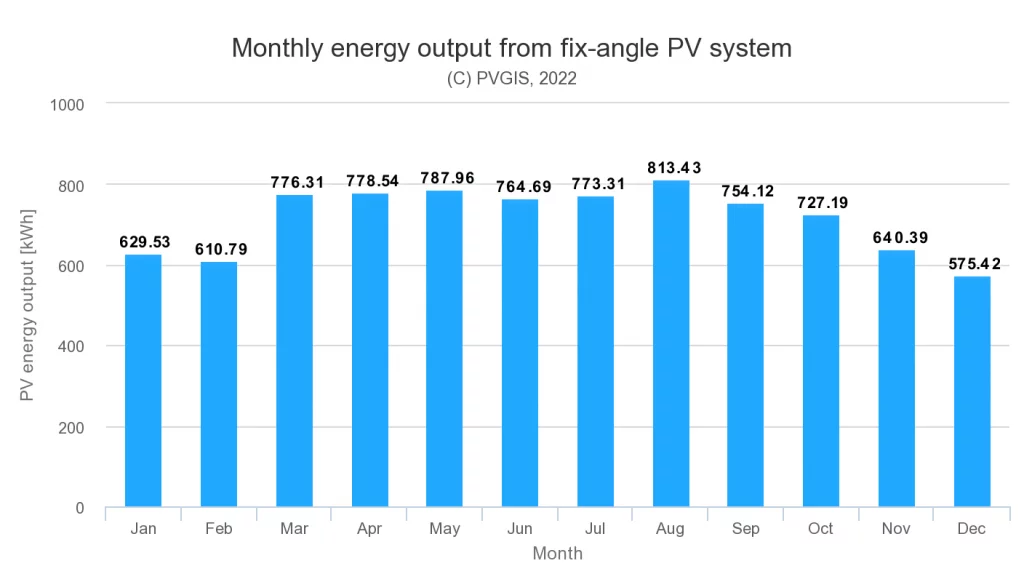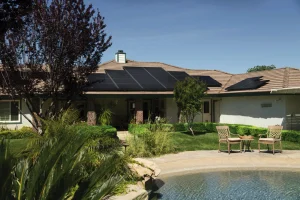What's on this page?
How to Calculate the Output of Solar Panels
Solar panels are sold with a peak wattage rating, which is their power output in ideal conditions. However they typically output significantly less on average.

The factors that influence how much power a given solar panel will output include:
- Rated peak power
- Location (places closer to the equator get more sunlight)
- Season
- Temperature of the panels
- Direction the panels are facing (in the US and Europe, south facing is usually best)
- If the panels are mounted on a sun tracker
- If there is any shading
- The type of inverter being used
- If there are multiple panels as part of an array:
- How that array is electrically connected
- If any micro inverters are used
- If the panels have bypass diodes
How to Calculate Solar Panel Output (Simple Method)
A simple way to work out the solar output in your location is to first get the number of hours of sunlight per day in your location. In the US that ranges from around 5 to 8 hours of sunlight per day.
Then use this formula:
Solar panel watts x average hours of sunlight x 75% = daily watt-hours
This gives you the amount of watt hours your solar panels will typically produce per day. You will probably be more familiar with killowatt hours (kWh) as that is how you’re billed by your utility company. So to convert watt hours to killowatt hours, you simply divide by 1,000.
For example, for 400 watt panel with 6 hours of sunlight:
400 w x 6hrs x 0.75 = 1,800 Wh
1,800 Wh / 1,000 = 1.8 kWh
More Accurate Method
A more accurate way is to use the EU PV GIS Database to get the exact solar irradience data for your location throughout the year. The reason this is more accurate is because it takes into account the average amount of cloud cover, how direct the sunlight is, and several other factors.
It’s the data source behind our solar savings calculator and off grid solar calculator.
How to Calculate the Return on Investment of Solar Panels
(Sometimes Thought Of As The ‘Payback Period’)
Whilst solar panels can be purchased simply to ‘go green’ and live a more sustainable life, or to meet ESG (Environmental, Social, and Governance) business targets, most buyers are also looking to get a financial return on investment too.
Typically this calculation is based on having a grid connected (grid tie) system, although off grid solar systems can also provide a good return on investment when compared to being grid connected or using diesel or propane generators.
Factors that decide return on investment:
- Initial cost of the solar installation
- How you pay for it (cash, loan, power purchase agreement, refinance, etc)
- Price of grid electricity where you are
- How much electric costs increase over the lifetime of your solar system
- Whether there are any government grants, or tax incentives which apply to you
- Whether or not you qualify for Net Metering, or get paid for exporting electricity, and how much
- The output of your solar system
- How much of the electricity you produce from your solar panels that you consume yourself vs exporting to the grid
Simple Method for Calculating Payback Time
The simplest manual method is:
- Work out the annual output of your solar system in kWh. You can use the formula above and then multiply by 365 to get the annual figure. This should be at least 100% of your annual electric consumption.
- Take the amount of electric you will ‘self consume’ from solar. A safe estimate if you aren’t planning on adding a battery is 45% of the electric you usually consume. With a battery you can use 70%. If you live somewhere with net metering, you can use 100% for this figure.
- Multiply this number by the rate that you pay per kWh for electric. This is your annual savings from ‘self consuming’ the solar energy you generate.
- If you live somewhere where you get paid to export electricity, for example the UK, then deduct your self consumption number in kWh from your solar system output.
- Take this number and multiply it by the rate you get paid to export.
- Add this figure to the money you saved from self consuming solar. This is your annual savings total.
- Divide the upfront cost of your system by the annual savings total you just calculated. This gives you the number of years for you to break even, or ‘payback’ your system.
Bare in mind that this does not account for rising electric costs, so this calculation will likely overestimate the number of years it takes to pay back.
How to Work Out How Much Battery Storage You Need to Go Off Grid
Going truly off grid means being totally self sufficient for all your electrical needs. So when designing your off grid system, you’ll need to factor in extra battery storage capacity to ensure you still have power when there are unusually dark days.
Depending on where you live, you could have very low levels of sunlight due to:
- Snow
- Storms
- Sand (see picture below)
- Erupting volcanoes (rare and you’ll probably have bigger issues)
The time that you can go without sunlight with off grid solar panels is referred to as the amount of autonomy. Off grid solar buyers typically design their systems with around 2 – 4 days of full autonomy.
To calculate how much battery storage you need, simply take your daily electric consumption in kWh and multiply it by the number of days of autonomy you need.
For example, if you use 5kWh per day in your cabin, and you want 2 days of autonomy, then you’ll need 10kWh worth of battery storage.
Batteries can’t use their full capacity without reducing their overal lifetime however, so you’ll need to factor this in when chosing one.
Most lithium based batteries (LiFePo4 are generally the best for off grid use) are able to use around 80% of their total capacity. This is sometimes referred to as their depth of discharge.
So you’ll need to take your required energy storage amount, then multiply it by the battery depth of discharge % divded by 100%. For example:
10kWh x (100/80) = 12.5kWh battery needed.






